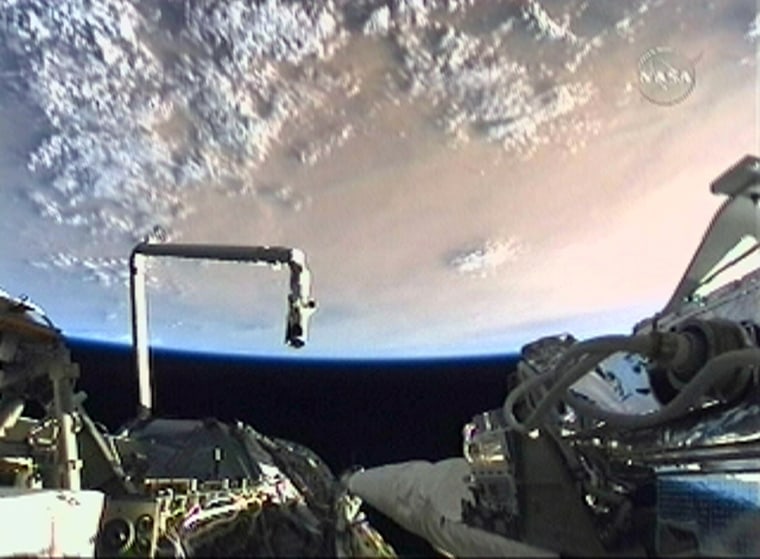With a 4-inch gap in the space shuttle Atlantis' heat-protecting blanket not appearing to be an urgent problem on Saturday, the crew readied themselves for what NASA called a delicate ballet with the international space station.
Then the shuttle will enter a weeklong embrace Sunday with the orbital outpost.
Atlantis' seven astronauts spent much of Saturday on a mandatory inspection of the shuttle's delicate heat tiles, outer edges and blankets for problems similar to the kind that caused the fatal Columbia accident in 2003. As of Saturday afternoon, no glaring problems were reported.
But late Friday and early Saturday, the crew spent extra time using a robot arm to look at a gap in a thermal blanket on the left side of the shuttle. The gap, about 4 inches by 6 inches (10 by 15 centimeters), appears to have been caused by air lifting the corner of the blanket up, John Shannon, chairman of the mission management team, said at a news conference.
"It's not a great deal of concern right now, but there's a lot of work to be done," Shannon said. "Other than that, the vehicle is very clean."
NASA engineers want to study more photos of the torn blanket, covering maneuvering engines at the tail of the shuttle, particularly images that were taken by cameras attached to the solid rocket boosters that separated from Atlantis more than two minutes into flight and then dropped into the Atlantic Ocean. The boosters are recovered by ships after each launch.
Using the images, engineers can build models and perform aerodynamic and thermodynamic tests to determine whether the lifted blanket would cause problems during Atlantis' re-entry into Earth's atmosphere at the end of the mission.
Engineers also plan to study past shuttle flights.
Thermal blankets came unstitched during flights of Discovery in 2005 and 2006 without any problems, and thermal tiles were lost in the same area where the peeled-up blanket is on Atlantis on two of the earliest shuttle flights.
The area does not get hotter than 1,000 degrees Fahrenheit (538 degrees Celsius) during the shuttle's return to Earth, compared with other parts of the vehicle where temperatures can get as hot as 2,900 degrees F (1,600 degrees C).
It is not a place where NASA is usually concerned about potentially fatal problems. But if engineers decided it needed to be fixed, Atlantis' astronauts could trim if off, tuck it back into protective tiles or cover it with a plate held in place by adhesive goo during three planned spacewalks or extra one added to the schedule.
After the Columbia disaster, a shuttle repair kit was included in all shuttle missions.
"We have wide spectrum of repair technologies," Shannon said.
A day for inspections
As part of the normal day-after-launch tile inspections, astronaut Patrick Forrester used the shuttle's robot arm and a boom extension to examine its wings and outer edges.
Atlantis' crew was given an extra half-hour to sleep Saturday morning, then awoke to the song "Big Boy Toys" by Aaron Tippin.
Atlantis' seven-man crew was closing the gap between it and the space station by about 800 miles (1,280 kilometers) every 90-minute orbit. Atlantis is scheduled to dock with the space station Sunday at 3:38 p.m. ET.
Before the docking comes maneuvering that NASA officials often call a delicate ballet, a procedure that has appeared effortless in 20 previous tries, even though it is risky.
"Two vehicles weighing 230,000 pounds going 17,500 mph, it's tough stuff," Shannon told The Associated Press.
Atlantis commander Rick Sturckow will move the shuttle until it is 600 feet (180 meters) below the station and then make the shuttle turn a 360-degree backflip in just nine minutes. The last few feet of the docking occur so slowly that Atlantis will get only an inch closer to the station every second.
Once the shuttle and station connect, they will stay locked until June 17.
Full agenda ahead
During the 11-day flight, the astronauts will deliver a new segment and a pair of solar panels to the orbiting outpost. They plan three spacewalks — on Monday, Wednesday and Friday — to install the new equipment and retract an old solar panel.
On Sunday, astronaut Clayton Anderson will replace astronaut Sunita Williams as the U.S. representative aboard the space station. Williams will return to Earth aboard Atlantis. She has spent the past six months in orbit.
The first shuttle launch of the year helped put NASA back on track after a run of bad luck and scandal on the ground during the first half of the year.
In the past few months, NASA has seen the arrest of astronaut Lisa Nowak in an alleged plot to kidnap her rival for a shuttle pilot's affections; a murder-suicide at the Johnson Space Center in Houston; and the derailment of a train carrying rocket-booster segments for future shuttle launches.
More recently, NASA Administrator Michael Griffin has come under fire for suggesting that global warming may not be a problem worth wrestling with. And the agency's inspector general was lambasted at a congressional hearing Thursday by former staff members, congressmen and senators for the way he managed his office, treated his employees and investigated complaints.
